Bringing Back the Old
Posted on June 11 2010 by Axle D. Wilder
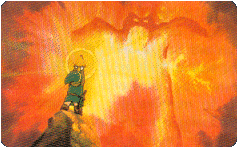 These days we seem to be hearing more and more talk about the Zelda series getting stale. Nintendo reusing the same structure in each game is a good example. And I don’t just mean the game in general (collect three items, plot twist, collect some more items, final showdown). I’m also talking about specific elements, such as dungeon structure. Even other elements of the series have been reused again and again. Villains, items, plot twists, kidnappings, magical objects.
These days we seem to be hearing more and more talk about the Zelda series getting stale. Nintendo reusing the same structure in each game is a good example. And I don’t just mean the game in general (collect three items, plot twist, collect some more items, final showdown). I’m also talking about specific elements, such as dungeon structure. Even other elements of the series have been reused again and again. Villains, items, plot twists, kidnappings, magical objects.
Some people argue that these elements are classic, and that they make the series what it is. I tend to agree with this for the most part, but I also agree with the other side: That the series really needs some freshness, But most of the time I hear people talking about radical changes. Switching up the gameplay entirely, adding more mature themes, making fundamental changes to Link’s character, etc.. I find that all a bit extreme, not to mention some of those things would be bad moves all around in my opinion.
But why don’t we just bring back the old qualities that have been lost since Ocarina of Time? I’m surprised I don’t hear of this more. When Ocarina of Time came around, it was revolutionary. Whether or not you like it, you can’t argue with that. It was the first 3D Zelda game. It kept key elements of Zelda while adding lots of new ideas and essentially founding the modern Zelda game as we know it. Every game since Ocarina of Time has borrowed it’s same core gameplay, including functions such as targeting, rolling, musical instruments, and so on. These were all new ideas at the time, but they were also based upon basic gameplay principles started in the old games. They expanded a lot on them, yes, but they didn’t change the core feel of the game.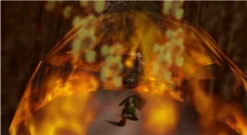 This sort of gameplay has always been at the heart of Zelda, and I think changing it would be something of a mistake. You might say “What about Adventure of Link? It was completely different!” but not so much. Think about it. In a lot of ways Ocarina of Time combined the first and third games with Adventure of Link. It threw in the magic spells, sword combat, mild platforming, and such, many of the key elements of the second game.
This sort of gameplay has always been at the heart of Zelda, and I think changing it would be something of a mistake. You might say “What about Adventure of Link? It was completely different!” but not so much. Think about it. In a lot of ways Ocarina of Time combined the first and third games with Adventure of Link. It threw in the magic spells, sword combat, mild platforming, and such, many of the key elements of the second game.
The story has always had a certain charm too. There’s always been a particular feeling to the story, and while I don’t mind changing the themes or event structure, I think entirely changing the feel, the emotion, would be a mistake. Even worse would be to inject more mature themes and make it more gritty or adult. There’s nothing wrong with a gritty storyline. It’s just not Zelda.
“Well then how do we freshen up the series?!” you might be asking. Well, that’s where my aforementioned point comes in.
Why are we even thinking about adding entirely brand new ideas? There were so many golden concepts introduced in the older games that were dropped entirely in Ocarina of Time, if not before then. These proved for a very different experience, while still keeping (actually, founding) the core principles of the series that make it Zelda. Some of these ideas could be AMAZING in a 3D, modern Zelda. Some of these ideas include:
Exploration
The original Legend of Zelda was revolutionary for it’s time for many reasons, not least of all it’s amazingly expansive landscape in which you were thrust without any maps, guidance or being pointed in the right direction. It was up to you to figure out where to go, how to get there, and what to do once you arrived. The dungeons, sidequests, items… everything. It was all scattered and hidden. This continued for the next two games, with Adventure of Link introducing towns and a wealth of other new sorts of areas.  A Link to the Past toned this concept down considerably, but it still had an expansive landscape and followed the same idea, leaving you to find your way with only minimal guidance.
A Link to the Past toned this concept down considerably, but it still had an expansive landscape and followed the same idea, leaving you to find your way with only minimal guidance.
Now imagine the expansive overworld of Twilight Princess. It was big, but it was plain, open and empty. Imagine it with the variety of unique terrain of the old games, and with it left for you to explore. Even better, imagine it with the graphical quality of Twilight Princess. Face it, as fancy as they may have been, every single 3D overworld (with perhaps an exception in The Wind Waker) was nothing but a hub.
Non-Linearity
These days, things are very straightforward in Zelda games. Do this dungeon, then go through some events to open up the next dungeon, and so on. Sometimes it was mixed up a little, but now with Twilight Princess things literally go from Point A to Point B (well, it more like it goes from Point A all the way through to Point Z and then into an expanded alphabet, but…). There’s no deviation. It’s a straight line. In the original Legend of Zelda, you could go anywhere and do anything at any time. Dungeons could be done mostly in any order. This was mostly true for A Link to the Past as well, once you got into the Dark World. Sure, there was some requirements to the order, but it was a lot more open and a lot more interesting.
Now, some arguments I’ve heard about this is the damage it would do to the story. That having things go in a straight line allows the story to be stronger. Why is that? Just because you can do things in different orders doesn’t mean you couldn’t still have an incredible plot as long as you were creative. What if you told individual stories deeply tied into the main plot at different dungeons you could do in any order, allowing the plot to be experienced differently? It doesn’t mean all dungeons have to be open in order. There can be limitations, like in A Link to the Past. It doesn’t have to hurt the story, as there’s many ways you can design the plot to work well in a non-linear game.
Magic
 The first game in the series had a few magical items. But it was Adventure of Link that really started this. It had the first Magic Meter in all of Zelda, and had a whopping 8 spells to use, more than any other game in the series. There was a lot of use of the spells both in advancing through the game and in combat itself. A Link to the Past didn’t exactly have spells, but it had three items functioning very similarly to them, and also had many other magic items which used the Magic Meter. Ocarina of Time was the only game to continue the tradition very much. Since then, the games contain less and less use of magic, and now some don’t have it at all. This added so much more depth, with the management of a second meter used for your most powerful attacks and the need to constantly refill it. What if we even went back to how it was in Adventure of Link? Hell, what if there were even more spells?
The first game in the series had a few magical items. But it was Adventure of Link that really started this. It had the first Magic Meter in all of Zelda, and had a whopping 8 spells to use, more than any other game in the series. There was a lot of use of the spells both in advancing through the game and in combat itself. A Link to the Past didn’t exactly have spells, but it had three items functioning very similarly to them, and also had many other magic items which used the Magic Meter. Ocarina of Time was the only game to continue the tradition very much. Since then, the games contain less and less use of magic, and now some don’t have it at all. This added so much more depth, with the management of a second meter used for your most powerful attacks and the need to constantly refill it. What if we even went back to how it was in Adventure of Link? Hell, what if there were even more spells?
RPG Mechanics
This one’s all Adventure of Link. The series has always been somewhat related to the RPG genre, but it was AoL that really embraced that connection. It featured a common RPG staple: experience and leveling up to increase your stats. Now, there’s countless ways of implementing RPG elements into Zelda again. RPGs are so many, so varied and diverse. Every year new ideas are tried. This is exactly why the arguments that it wouldn’t work in Zelda don’t hold water, because there are too many concepts with RPGs for it to be possible that ALL of them aren’t perfect for Zelda. Imagine the depth and replay value this could add? It’s exciting to think about.
Leveling might be a bit much. But how about stat boosts like defensive or damage upgrades? They had stat boosting equipment in Link’s Awaking, A Link to the Past, and even the original Legend of Zelda.
A deeper system for acquiring upgrades could also be intriguing. We’ve had special sword skills in both Twilight Princess and The Minish Cap. There’ve been magic in many games, as I’ve mentioned before. What if optional combat-based skills could gradually be learned like in RPGs? Or even passive skills. Just an assortment of traits to customize your combat style.
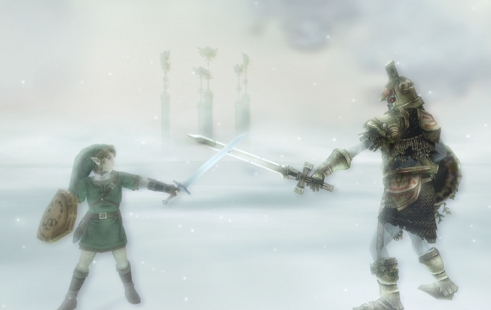
Accessories, like the rings in the Oracle games. Not only does it add depth to collecting and finding all the secrets, but it also adds another level to the gameplay, as well as the customization.
Status effects, equipment, more dialogue, a party of playable or support characters… While not all of these concepts are necessarily perfect for Zelda, it’s hard to argue in the potential of taking cues from RPGs. As I’ve already said, it’s not that hard to fit the pieces together and meld them with Zelda’s established formula.
Difficulty
Let’s face it, most of the Zelda games since Ocarina of Time have been really easy. Especially the last batch, like The Wind Waker, Twilight Princess, not to mention the DS pair Phantom Hourglass and Spirit Tracks.
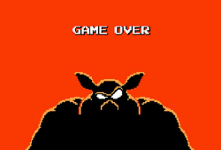 Some of the elements I’ve already discussed attribute to difficulty. Especially Exploration and Non-linearity. But is being hard really a bad thing? There are always strategy guides, and you can always just expand in-game help features like Navi or Midna. At the very least, some of the puzzles should be hard to figure out, some of the enemies should be tricky, and some of the bosses should pose a challenge.
Some of the elements I’ve already discussed attribute to difficulty. Especially Exploration and Non-linearity. But is being hard really a bad thing? There are always strategy guides, and you can always just expand in-game help features like Navi or Midna. At the very least, some of the puzzles should be hard to figure out, some of the enemies should be tricky, and some of the bosses should pose a challenge.
I can understand the series needing to be accessible to casual gamers, but that’s no reason to make it unbearably easy. Difficulty adds depth and replay value. See my next old idea for a particularly nice way to make things harder…
Second Quest
The original Legend of Zelda was big. It had a whopping 9 dungeons, and even once you beat them all, it wasn’t over. The game started over. Not only was it different, with dungeons moved around, bosses changed, etc., but it was HARDER!
The Wind Waker also kind of had a Second Quest, but all it did was give you a different outfit, give you the Delux Picto Box from the start, let you keep all the Figurines you’d already collected in your last game, and translate all the gibberish some characters spoke. These were minor little perks.
So here’s a crazy thought: What if we brought back the Second Quest, but made it more like Ocarina of Time: Master’s Quest? Master’s Quest was essentially a re-release of Ocarina of Time, but all the dungeons were remixed with harder puzzles and more enemies. What if the Second Quest were like this? What if the first quest was easy for the casual gamers, but the Second/Master Quest was nice and difficult? This is the perfect compromise if you ask me.
Odder and More Numerous Items
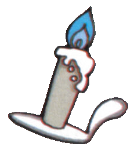 The first two Zelda games in particular had a lot more items, all with odder and more specialized uses. I thought this was really neat and added some more depth and fun to the game. Instead of adding tons of full-on weapon items like in the modern games, how about have more of these? It could add a lot more length and fun to things.
The first two Zelda games in particular had a lot more items, all with odder and more specialized uses. I thought this was really neat and added some more depth and fun to the game. Instead of adding tons of full-on weapon items like in the modern games, how about have more of these? It could add a lot more length and fun to things.
Items like the Bait, Raft and Ladder, Cross, Candle, and so on. These had nice, simple purposes that gave you more to find and more to do, giving you an expansive inventory. Imagine this done now. There could be lots more cool sidequests, pre-dungeon quests, and inventive puzzles.
You could even have more odd tool-type items like the Lantern that are required for basic tasks like navigating the dark. You could have a variety of “tool” items to make exploration more interesting and add more depth to resupplying and preparing for your next journey.
More Optional Upgrades and Items
The original Legend of Zelda in particular had a ton of special items and upgrades you could get to become more powerful and make your quest easier. In fact, every sword, shield and defense upgrade in the game was optional. There were even more optional, interesting upgrades in A Link to the Past. And this goes for items too. How about the Magic Cape? Cane of Byrna? Magic Powder?
Having optional goodies is fun and makes 100% completion more challenging and interesting. Also, if they were expanded on the items more, making them not as useless as some of the optional items in A Link to the Past, it could be even better.
Equipment System
The only thing on my list that started with Ocarina of Time. Ocarina of Time had a variety of clothes that allowed Link to survive in extreme environments.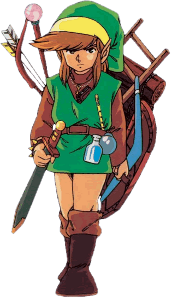 He had a variety of other equipment too. Boots, that afforded him different movement abilities, like being heavy or hovering. Shields, the first two of which were just upgrades, but then there was the unique Mirror Shield, which allowed you to reflect things. The Swords were probably the least creative, but with new items in the series like the Four Sword, you can see the possibilities.
He had a variety of other equipment too. Boots, that afforded him different movement abilities, like being heavy or hovering. Shields, the first two of which were just upgrades, but then there was the unique Mirror Shield, which allowed you to reflect things. The Swords were probably the least creative, but with new items in the series like the Four Sword, you can see the possibilities.
With the possible exception of the occasional annoyance of having to switch all the time, I think the return of the Equipment System is in order. What if there was more clothing to adapt to new environments? Or what if that clothing gave you new abilities like the Zora Armor in Twilight Princess did? What if there were new shields, or if you sometimes had to avoid using the metal shield because of… say electricity… or magnetism. More boots, like walking on water. Swords with different traits or powers, or maybe even different weapons like in The Wind Waker but expanded.
This added a lot of depth in my opinion, and if you coupled it with the return of RPG elements, it could be especially exciting. That’s all I have for my list, but I’m sure that are many more possibilities you could think of. All of these ideas have been neglected or dropped entirely since Ocarina of Time, and if properly implemented, they could make for a breathtaking, unbelievable Zelda experience.
Why do we need to change fundamentals of the series when we can bring back it’s roots in full force in exciting new ways? With 3D gameplay and environments, all of these ideas have infinitely more potential. Sure, there’s good and bad ways of doing it, but Nintendo’s done pretty good so far, haven’t they? And they sure worked the first time, so why not now? It’s the perfect time for a little nostalgia, wouldn’t you agree?



